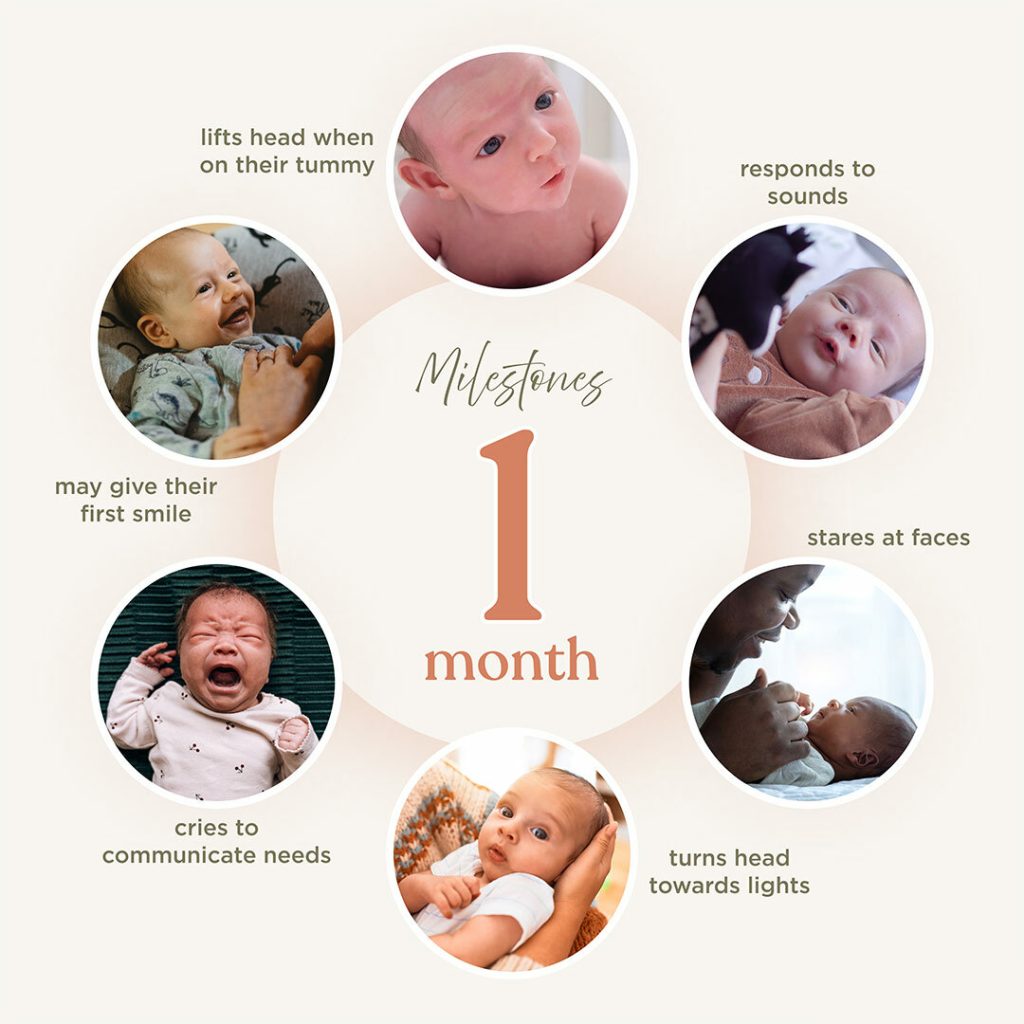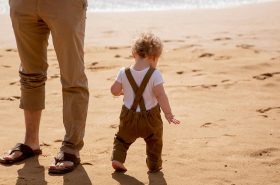
We have already announced our brand-new blog series “Milestones” and now it’s here! We’ll be sharing all the baby developmental milestones that your little one goes through up to their first birthday. Month by month. With the help of our lovely midwife and baby expert Katrin. Today in focus: “your 1 month old baby”.
So, what happens in your baby’s development during the first four weeks after birth? Firstly, we would like to emphasise that every baby is an individual and develops at their own pace. Some move quicker in terms of motor skills, and others make faster cognitive progress. The following developmental stages are therefore merely guidelines. If your child is not yet showing one or two skills, give them time. It will come. And if you are ever concerned, you should talk to your midwife, health visitor or GP about whatever is troubling you.
1 month baby milestones:

They lift their head while in the prone (tummy time) position
You know the drill: your baby’s head needs a lot of support in the first few months of life. Their neck muscles are simply not strong enough to support their head and still need to be trained. By the end of the first month, however, your little one may already be trying to lift and hold their head for a moment when lying on their tummy [LINK TO TUMMY TIME BLOG]. Perhaps they will even attempt a tiny turn of their head before it plops back into its original position as it is still too heavy to hold.
It is very important to know that your baby cannot turn their head as far as we adults can. We are talking about approx. 45 degrees from the centre of the body to the side and only with a minimal movement of the head backwards.
But what does this mean in everyday life?
When carrying your baby, for example, your baby cannot lay its ear flat on your chest, but rather touches your body with its cheek. It is therefore also important that you do not wrap their head up in a Baby Wrap, for example (their face must always be visible so you can ensure they are breathing!) or fix it in place with a wrap or carrier. This only exerts pressure on the upper cervical vertebrae and leads to a forced posture. In addition, the pressure on the back of their head can also impair swallowing. It is therefore better to support the head up to the middle of the ear (in a wrap, for example, you can a roll a small flannel into the top edge of the sling, or in the baby carrier use the adjustable neck cushion).
Did you know that the neck cushion of our Omni and Adapt baby carriers can be folded inwards for newborns? This gives your baby even more support in the head area and reduces the space in the baby carrier. Cool right?
Your baby reacts to sounds
After birth, your baby’s hearing is already fully developed, but still needs to mature over the next few years. Of course, brain development and the processing of sounds also play a major role here.
In the first month of life, your newborn baby will listen to all sounds with fascination. They are particularly captivated by high-pitched sounds. They also love to hear the familiar voices of their family from the womb. Soon after birth, your little one will even be able to distinguish their mother’s voice from others and, with increasing hearing experience, he will quickly recognise the differences between individual sounds. If you sang or played certain bedtime songs to your baby before birth, they will also find them familiar.
They observe faces intensely
You may be wondering: what can a 1 month old baby see? The answer is: not much. But not nothing either.
Vision can only develop after birth, when the first ray of light hits the retina. This is very important, also for your child’s motor development. They need “visual orientation” as a motivator for movement, so to speak.
At first, everything they see is very blurred, like looking through a frosted glass. You will be able to observe that your baby’s eyes move back and forth uncontrollably, as they are not yet able to focus their eyes on an object in their first few weeks. What they can (and love) to do at the end of the first month, however, is to study your face intensely and with fascination when it is approximately 20 to 30 centimetres away from its own. Because that is the only distance it can perceive at this time. So, keep making exaggerated but affectionate “faces” to entertain your baby and encourage its development. Your baby should be able to focus on a face or toy by 8 weeks at the latest.
If they haven’t met this, or any other 1 month baby milestones, please have them checked over by a paediatrician.
Your baby turns their head towards the light
While your baby cannot see very far in their first weeks of life, they react very well to light and dark. If there is a bright window in the room, they will move their head in that direction. When a dark object moves in front of them, they will also perceive this shadow. If a bright light suddenly flashes your baby is guaranteed to react to it.
Your newborn’s language
Your baby’s first communication with you is their cry. They’ll also show many other language signs before they talk, you just have to understand them. Take your time to get to know and read your baby. It’s your job to respond to their needs appropriately and promptly. This is called co-regulation. Your baby doesn’t know what the right answer is when they are tired, for example. They don’t know that the way to fix their tired feeling is to fall asleep. If you respond by changing their nappy instead of helping them to fall asleep your child will probably cry to tell you their need hasn’t been met.
Baby’s first smile
You look at your baby and there it is: the first smile. It suddenly flits across their face and your heart bursts. However, this first smile is the so-called angel smile. It is not a conscious movement, but a reflex that shows that visual and social areas of the brain are developing. The reflex is comparable to the jerky arm and leg movements that your baby makes when exploring and testing its body parts.
Most babies do not show their first conscious smile, also known as a social smile, until they are around six weeks old. However, it could mean that your little one is perhaps simply early and has already mastered this move. In any case, this first conscious smile is the first big step on the way to consciously interacting and communicating with the world around them. A real milestone.

Baby developmental milestones: your 1 month old baby
Wow! All these baby developmental milestones in just one month? It seems unbelievable that all this is happening in your 1 month old baby’s body and mind in such a short space of time. They’re a miracle! And wait until you see the next few months… it doesn’t get any less. On the contrary! We hope you were able to take something away from the baby’s development in the first month and can now experience this for yourselves with your little miracle at home. But please remember, every baby develops at their own pace! If you have any concerns, then seek professional advice.



